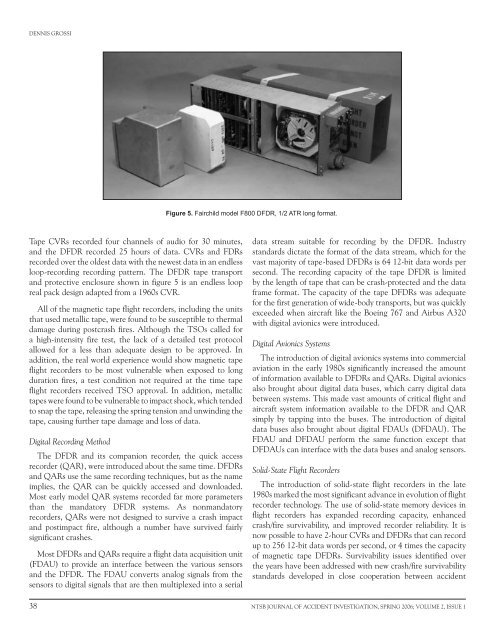Journal of Accident Investigation
Journal of Accident Investigation
Journal of Accident Investigation
Create successful ePaper yourself
Turn your PDF publications into a flip-book with our unique Google optimized e-Paper software.
DENNIS GROSSI<br />
Tape CVRs recorded four channels <strong>of</strong> audio for 30 minutes,<br />
and the DFDR recorded 2 hours <strong>of</strong> data. CVRs and FDRs<br />
recorded over the oldest data with the newest data in an endless<br />
loop-recording recording pattern. The DFDR tape transport<br />
and protective enclosure shown in figure is an endless loop<br />
real pack design adapted from a 1960s CVR.<br />
All <strong>of</strong> the magnetic tape flight recorders, including the units<br />
that used metallic tape, were found to be susceptible to thermal<br />
damage during postcrash fires. Although the TSOs called for<br />
a high-intensity fire test, the lack <strong>of</strong> a detailed test protocol<br />
allowed for a less than adequate design to be approved. In<br />
addition, the real world experience would show magnetic tape<br />
flight recorders to be most vulnerable when exposed to long<br />
duration fires, a test condition not required at the time tape<br />
flight recorders received TSO approval. In addition, metallic<br />
tapes were found to be vulnerable to impact shock, which tended<br />
to snap the tape, releasing the spring tension and unwinding the<br />
tape, causing further tape damage and loss <strong>of</strong> data.<br />
Digital Recording Method<br />
The DFDR and its companion recorder, the quick access<br />
recorder (QAR), were introduced about the same time. DFDRs<br />
and QARs use the same recording techniques, but as the name<br />
implies, the QAR can be quickly accessed and downloaded.<br />
Most early model QAR systems recorded far more parameters<br />
than the mandatory DFDR systems. As nonmandatory<br />
recorders, QARs were not designed to survive a crash impact<br />
and postimpact fire, although a number have survived fairly<br />
significant crashes.<br />
Most DFDRs and QARs require a flight data acquisition unit<br />
(FDAU) to provide an interface between the various sensors<br />
and the DFDR. The FDAU converts analog signals from the<br />
sensors to digital signals that are then multiplexed into a serial<br />
Figure 5. Fairchild model F800 DFDR, 1/2 ATR long format.<br />
data stream suitable for recording by the DFDR. Industry<br />
standards dictate the format <strong>of</strong> the data stream, which for the<br />
vast majority <strong>of</strong> tape-based DFDRs is 64 12-bit data words per<br />
second. The recording capacity <strong>of</strong> the tape DFDR is limited<br />
by the length <strong>of</strong> tape that can be crash-protected and the data<br />
frame format. The capacity <strong>of</strong> the tape DFDRs was adequate<br />
for the first generation <strong>of</strong> wide-body transports, but was quickly<br />
exceeded when aircraft like the Boeing 767 and Airbus A320<br />
with digital avionics were introduced.<br />
Digital Avionics Systems<br />
The introduction <strong>of</strong> digital avionics systems into commercial<br />
aviation in the early 1980s significantly increased the amount<br />
<strong>of</strong> information available to DFDRs and QARs. Digital avionics<br />
also brought about digital data buses, which carry digital data<br />
between systems. This made vast amounts <strong>of</strong> critical flight and<br />
aircraft system information available to the DFDR and QAR<br />
simply by tapping into the buses. The introduction <strong>of</strong> digital<br />
data buses also brought about digital FDAUs (DFDAU). The<br />
FDAU and DFDAU perform the same function except that<br />
DFDAUs can interface with the data buses and analog sensors.<br />
Solid-State Flight Recorders<br />
The introduction <strong>of</strong> solid-state flight recorders in the late<br />
1980s marked the most significant advance in evolution <strong>of</strong> flight<br />
recorder technology. The use <strong>of</strong> solid-state memory devices in<br />
flight recorders has expanded recording capacity, enhanced<br />
crash/fire survivability, and improved recorder reliability. It is<br />
now possible to have 2-hour CVRs and DFDRs that can record<br />
up to 2 6 12-bit data words per second, or 4 times the capacity<br />
<strong>of</strong> magnetic tape DFDRs. Survivability issues identified over<br />
the years have been addressed with new crash/fire survivability<br />
standards developed in close cooperation between accident<br />
38 NTSB JOURNAL OF ACCIDENT INVESTIGATION, SPRING 2006; VOLUME 2, ISSUE 1
















